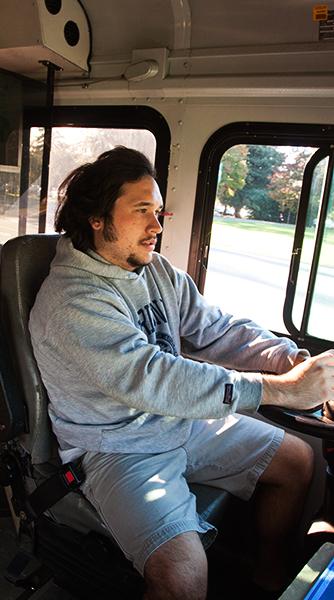Shuttle cuts could save $100,000 a year

Hornet Shuttle:Hornet Shuttle driver Ethan Perez explains that buses are usually crowded from Monday to Thursday and shares disappointment over the elimination of the Gold Line, which has the most ridership.:Dan Ward – State Hornet
November 16, 2010
Students expressed their outrage last week over the proposed major cuts to the Hornet Shuttle, which includes eliminating early and late morning, midday and evening routes.
The University Transportation and Parking Services held a forum on Nov. 10 and Tuesday to seek student and staff input about the proposed changes to the Hornet Shuttle. The proposed changes would save the university nearly $100,000 annually, according to UTAPS.
“It’s ridiculous. It’s really sad because for most students, that’s their main use of it, being able to get back and forth to school, back and forth to their lives. That’s what gets me here,” said junior deaf studies major Shamika Newman, who attended the forum last week. “It’s tragic; there’s not much more to say than it’s depressing, frustrating and infuriating really.”
Based on the proposed changes, the shuttle, which now runs continuously from 6:50 a.m. to 6:20 p.m., will only run from 7:50 to 9:40 a.m. and not start again until 2:20 p.m. The end run will be at 4:20 p.m.
“The proposed changes will reduce hours of operation, thereby reducing operating costs sufficiently to allow the program to operate within its budget,” said Abigail Stone, associate vice president of business and administrative services. “The schedule changes will also eliminate the times when there is the least average number of riders, which will allow the buses to run at greater capacity.”
Newman questioned the decision to eliminate that chunk of time from the schedule, pointing out that it did not seem necessary and would be highly inconvenient for a student to have to take the shuttle to campus and not be able to take another one until hours later.
Stone and Alfredo Orozco, UTAPS director, told students the midday block was eliminated from the schedule because the time frame had low ridership, and the empty time slots will be used to refuel the shuttles.
According to UTAPS, this would save the university about $46,000 annually.
Shuttle drivers, who attended the forum, expressed their concerns of losing jobs or work hours because of the shortened routes.
Stone said UTAPS is still working on the drivers’ schedules, so unless the proposed changes were approved, there would not be a clearer idea of the shifts.
A second change proposed was the elimination of the Gold Line, which serves the Arden and Howe areas and has the highest ridership. UTAPS is eliminating the line because it covers the same route as Regional Transit’s Route 82.
This would save the university about $50,000 annually, according to UTAPS.
Stone and Orozco acknowledged that many students’ schedules and routes to school would be affected by these changes. But they stressed throughout the forum that there are many city buses to accommodate any routes that would be altered by these proposed changes.
“Students can ride Regional Transit buses and light rail at no extra charge with a OneCard and the Commuter Pass (sleeve), carpool with other students who have similar schedules and/or live in the same area, or continue to ride the Hornet Shuttle during its hours of operation,” Stone said.
Stone said the changes are necessary because the Hornet Shuttle’s expenses are expected to increase due to fuel, maintenance and other expenditures, while revenue will stay the same.
Cayla Gales can be reached at [email protected].
























































































































